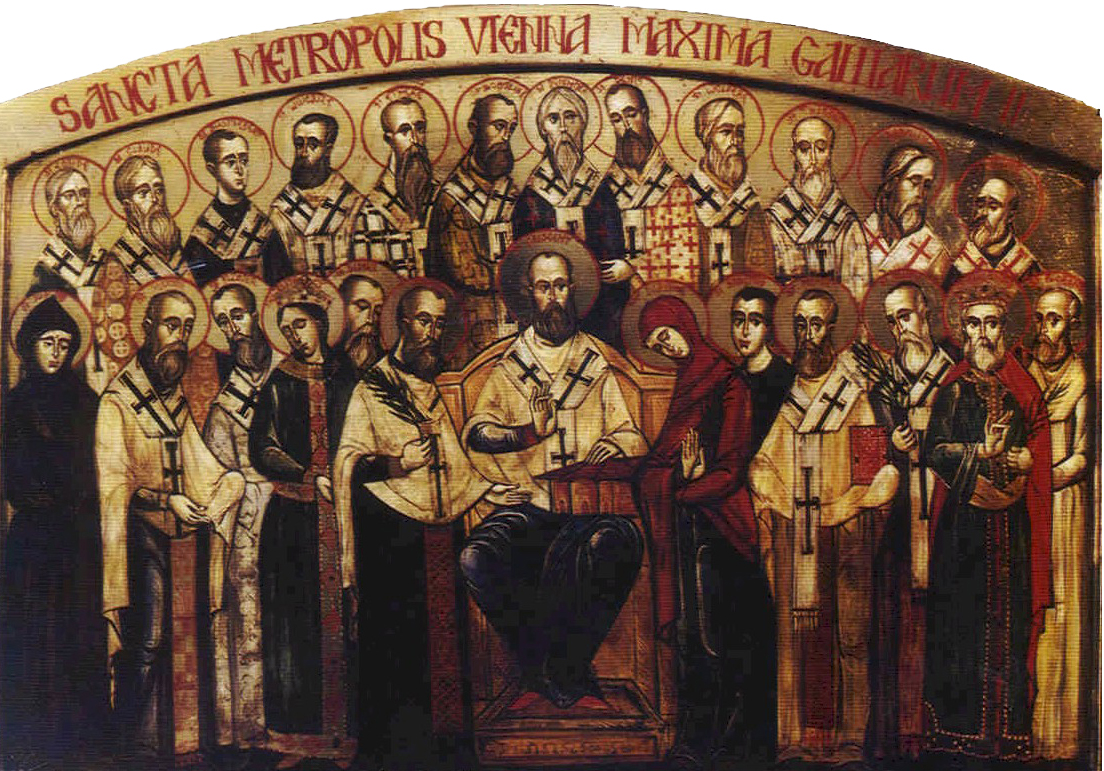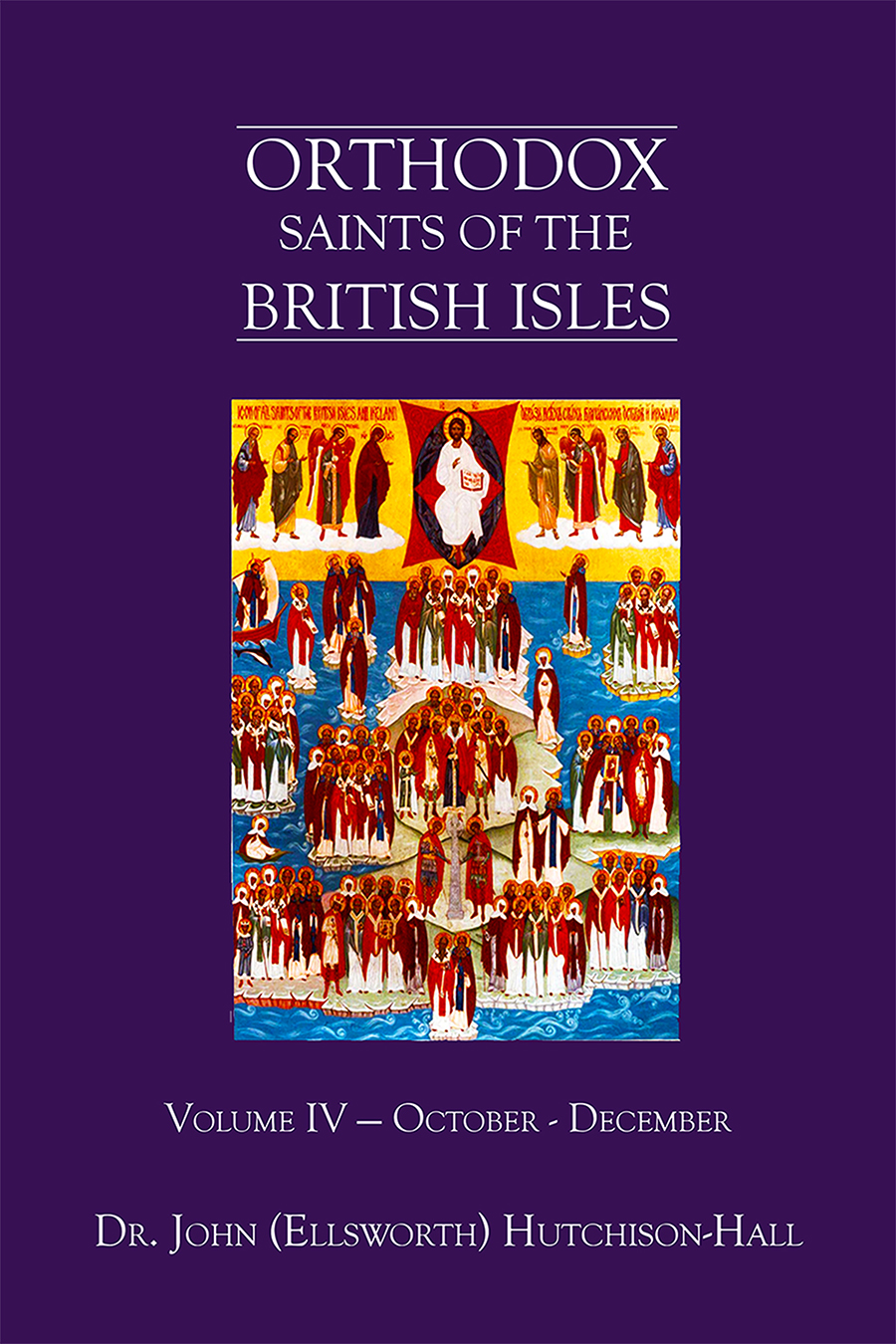
Orthodox Saints of the Pre-Schism
See of Rome
27th October (NS) — 14th October (OS) 2024
ANGADRISMA (ANGADRÊME) of BEAUVAIS, following education at Thérouanne Abbey (northern France) under the direction of St. Omer (9th September), and her cousin St. Lambert of Lyons (14th April), St. Angadrisma received monastic tonsure from St. Audoenus of Rouen (24th August). Ultimately, she became Abbess of the Abbey of Oroër-des-Vierges which was near Beauvais in Picardy (northern France). St. Angadrisma reposed circa 695–698.
BERNARD of ARCE, most likely a native of the British Isles, following a pilgrimage to the Holy Land and Rome, St. Bernard settled as a hermit in Arpino in Lazio (present-day Italy). His relics are enshrined in Rocca d'Arce about 100km / 62mi south-east of Rome.
BURCHARD of WÜRZBURG (BURKARD), an Anglo-Saxon priest from Wessex and disciple of St. Boniface of Mainz (5th June), who joined St. Boniface on his mission to the Germans. Consecrated first Bishop of Würzburg in Bavaria (southern Germany) in 741, St. Burchard was highly successful in spreading the Gospel and oversaw the founding of several monasteries whilst Bishop. He reposed circa 754 and was buried at Mount Saint Mary’s (Old Würzburg). In 983 St. Burchard's relics were translated to the Abbey of St. Andrew at Würzburg, which was later renamed in St. Burchard’s (Kloster St. Burkard) honour.
CALLISTUS (CALLIXTUS) I, ordained to the deaconate by Pope St. Zephyrinus (26th August) who placed him in charge of caring for the Christian burial grounds on the Via Appia (later named the cemetery of San Callistus). Upon the repose of St. Zephyrinus in 217, St. Callistus was elected his successor by popular acclaim. As Pope of Rome, he excommunicated Sabellius, though in general, was compassionate towards repentant sinners, establishing the practice of the absolution of all repented sins. It seems most likely that St. Callistus was martyred circa 222 at Todi in Umbria (central Italy).
DONATIAN (DONAS) of REIMS, a native of Rome, St. Donatian was consecrated in 360 the seventh Bishop of Reims (north-eastern France) in 360, and served that See until his repose in 390. In the mid-ninth century St. Donatian's relics were translated from the Royal Abbey of St. Peter of Corbie (abbaye royale Saint-Pierre de Corbie) in Picardy (northern France) to Bruges (north-west Belgum), where they were enshrined in the cathedral church which now bears his name. St. Donatian is the patron saint of Bruges, Belgium.
FORTUNATUS of TODI, the patron saint of Todi in Umbria (central Italy), St. Fortunatus was a sixth century Bishop of that See, who, according to tradition protected Todi during a siege by the Goths. St. Gregory the Dialogist (3rd September) took great interest in St. Fortunatus’ life, called him a man of great virtue. St. Fortunatus reposed in 537, his relics are enshrined in the church of San Fortunato in Todi.
GAUDENTIUS of RIMINI, originally from Ephesus (present-day Selçuk, Turkey), St. Gaudentius became a Christian and was later ordained to the Priesthood in Rome. In 346 he was consecrated Bishop of Rimini (northern Italy), St. Gaudentius was a participant of Council of Rimini of 357. He was martyred by Arians in 360.
JUSTUS (JUST) of LYONS, (Also 2nd September), a deacon in Vienne (south-eastern France) who in 350 was consecrated the 13th Bishop of Lyons (east-central France). St. Justus was one of the participants at the Council of Aquileia (381) which dealt with Arianism. Shortly after the council, St. Justus resigned his See and, with his deacon, went to Egypt where he lived as a hermit until his repose in 390. Shortly after his repose, his body was brought back to Lyons where he was buried at what came to be the Basilica of Saint-Just.
MANACCA (MANAKUS, MANACCUS), a sixth century Abbot of Holyhead in Wales, and a contemporary of St. Cybi of Caernarvon (8th November). From the information available it appears that he spent his later years in Cornwall.
MÉNEHOULD (MANEHILDIS), one of six or seven sisters, all of whom are venerated as saints in the present-day Champagne-Ardenne region in north-western France. St. Ménehould was a hermit and is the patron saint of the town of Sainte-Menehould in the Champagne-Ardenne region. She reposed circa 490.
RUSTICUS of TRIER, the twenty-seventh Bishop of Trier in the present-day German state of Rhineland-Palatinate. St. Rusticus was forced to resign his See following accusations of sexual impropriety (possibly from his youth). He retired to St. Goar of Aquitaine's (6th July) hermitage where the present-day town of Sankt Goar-Oberwesel in Rhineland-Palatinate, Germany is located. St. Rusticus reposed at the hermitage in 574.
Get your copy of Orthodox Saints of the British Isles today.
Available at Amazon or your favourite e-bookstore.
ABBÁN of MAGH-ARMUIDHE, (Sixth Century), the nephew of St. Kevin of Glendalough (3rd June) and the founder of many monasteries. He is often confused with St. Abbán of Kill-Abban (16th March) who was the nephew of St. Ibar of Meath (23rd April) and founder of Kill-Abban monastery in Leinster, Ireland. Unfortunately, there is no reliable Life of either of these saints extant.
Troparion of St. Abbán of Magh-Armuidhe — Tone VIII
In Ireland's fertile soil thou didst plant the seeds of
monasticism, O Father Abbán,/ and didst nurture
a great flowering of God-pleasing virtue./ Continue
steadfastly in thy enduring love, to lead mankind to
God/ and by thy prayers may we be granted great mercy.
COLMÁN of SENBOTH-FOLA, little is known of St. Colmán. He was Abbot of Senboth-Fola near Ferns in Ireland and is believed to have been a disciple of St. Áedán of Ferns (31st January). St. Colmán reposed circa 632.
Troparion of St. Colmán of Senboth-Fola — Tone VIII
Through trials and temptations thou didst shepherd/
steadfastly in thy enduring love, to lead mankind to
the monastics of Senboth-Fola, O Father Colmán,/
steadfastly in thy enduring love, to lead mankind to
and didst guide many souls on their pilgrimage to Christ./
Wherefore, we pray thee, intercede with Him,
that our souls may be saved.
DESIDERIUS (DIDIER) of AUXERRE, consecrated the twentieth Bishop of Auxerre in Burgundy (east-central France) in 614, St. Desiderius served the See until his repose in 625.
FLORENTIUS of TROIS-CHÂTEAUX, a third century martyr in Trois-Châteaux in Burgundy (east-central France). No further information on his life is extant.
GAUDIOSUS the AFRICAN (GAUDIOSUS of NAPLES), amongst the many orthodox Christians forced into exile by the Arian Gaiseric, King of the Vandals (r. 428–477), was St. Gaudiosus, Bishop of Abitina in Africa Proconsularis. Exiled in 440, St. Gaudiosus settled in Naples where he founded a monastery and lived until his repose circa 455.
NAMATIUS (NAMACE) of CLERMONT, the ninth Bishop of Clermont (central France), serving from circa 446 until his repose circa 462. His episcopacy is principally remembered for the building of the Cathedral of SS. Vitalis and Agricola. In History of the Franks (II.xvi), St. Gregory of Tours (17th November) wrote a detailed summary of the completed cathedral of which he says "the fear of God is in it".
ODHRAN (ODRAN, ÓRAN, OTTERAN) of WATERFORD, St. Odhran has always been held in great veneration in Ireland. He was an abbot in Co. Meath, Ireland, accompanied St. Columba of Iona (9th June) to Scotland, and is said to have been the first person to repose at Iona (circa 563). The graveyard at Iona is called Reilig Odhráin (St. Odhran’s Graveyard) in his memory. According to Irish tradition, St. Columba saw devils and angels fight over St. Odhran’s soul before it ascended into heaven. St. Odhran is also the main patron saint of the Diocese of Waterford, Ireland.
Troparion of St. Odhran of Waterford — Tone VIII
O Father Odhran, thou wast the first among the
saintly Columba's disciples to repose/ and be laid to
rest in the blessed soil of Iona./ As in thy life thou
didst live only for Christ,/ we pray thee to intercede
for us that we may follow thee into the way of salvation.
VINCENT, SABINA, and CHRISTETA, Martyrs of Avila, three Spanish Christians, and siblings, who were martyred during the Diocletianic Persecution (303–313).
Prior to the Schism the Patriarchate of Rome was Orthodox, and fully in communion with the Orthodox Church. As Saint John of Shanghai and San Francisco +1966 said “The West was Orthodox for a thousand years, and her venerable Liturgy is far older than any of her heresies”.
Details of British Saints excerpted from Orthodox Saints of the British Isles.
Details of continental saints from these sources.
In many cases there are several spelling versions of the names of saints from the British Isles. I use the Oxford Dictionary of National Biography version as the primary version with the more prevalent version in parenthesis e.g. Ceadda (Chad) of Lichfield.

